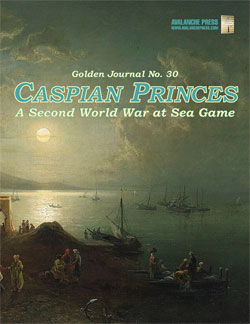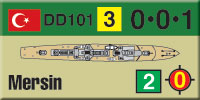| Golden Journal No. 30
Caspian Princes:
Designer’s Notes
by Mike Bennighof, Ph.D.
October 2023
 Our Second Great War alternative history setting is rooted in a reality where Woodrow Wilson’s late 1916 attempt to forge a negotiated end to the First World War is successful. In our actual history, Wilson tried to bring the war to a close, but failed when in pursuit of total victory Germany would not name her demands so that talks could even begin. Our Second Great War alternative history setting is rooted in a reality where Woodrow Wilson’s late 1916 attempt to forge a negotiated end to the First World War is successful. In our actual history, Wilson tried to bring the war to a close, but failed when in pursuit of total victory Germany would not name her demands so that talks could even begin.
The peace settlement in our story leaves the great empires of Eastern Europe more or less intact: Germany, Austria-Hungary, Russia and the Ottoman Empire. And while they learn some lessons from the war, and most begin to treat the working class with a great deal more respect, other fundamental flaws remain. Great Power games continue, as the power blocs cooperate only with one another, and by 1940 war returns as the Allied Powers (Russia, France and Italy, assisted by Belgium and Serbia) attack the Central Powers (Germany, Austria-Hungary, Turkey, Poland and Sweden).
War between Turkey and Russia means naval war on the Black Sea, which we cover in the Second Great War at Sea: Sword of the Sea expansion book. But that’s not the only theater of war; there’s also conflict on the Caspian Sea.
 Second Great War at Sea: Caspian Princes is the theme of our Golden Journal No. 30. It’s a complete game in a tiny package, with real die-cut and silky-smooth playing pieces and a (small) operational map. There’s the standard small Golden Journal booklet, with scenarios and story. The rules, charts and the tactical map are all downloadable; if you own another Second World War at Sea game you can just use those and not bother with the download part. Second Great War at Sea: Caspian Princes is the theme of our Golden Journal No. 30. It’s a complete game in a tiny package, with real die-cut and silky-smooth playing pieces and a (small) operational map. There’s the standard small Golden Journal booklet, with scenarios and story. The rules, charts and the tactical map are all downloadable; if you own another Second World War at Sea game you can just use those and not bother with the download part.
Why the Caspian Sea? Well, I can make it fit the story line pretty easily, since Turkey is at war wit Russia and eventually with Russian-allied Iran. And no one, as far as I know, has ever designed a naval wargame set on the Caspian Sea. Why would they?
 I wanted something unique to give the Gold Club a very different experience. Caspian Princes is intended to introduce players to the Second Great War at Sea, and to the Second World War at Sea game series. About two-thirds of the members play our naval games, and some of those don’t delve into alternative history. I aim to both change that, and maybe bring some more members into the Gold Club, too. I wanted something unique to give the Gold Club a very different experience. Caspian Princes is intended to introduce players to the Second Great War at Sea, and to the Second World War at Sea game series. About two-thirds of the members play our naval games, and some of those don’t delve into alternative history. I aim to both change that, and maybe bring some more members into the Gold Club, too.
One of the benefits of alternative history, from a game design perspective, is that you get to make it all up. Not that there aren’t “historical” games out there where the designer did that, too. But here we’re saying so right up front: none of this ever happened. When you make it all up, then you can make it up to suit your purposes, like making it all fit in the Golden Journal format.
 The Caspian Sea fits very snugly on a single 8.5x11-inch map, so it’s perfect for our purposes. It’s at the same scale as the full-sized games in the series (36 miles across each sea zone), and covers the entire sea as it existed in 1940 (climate change, and environmentally-catastrophic irrigation schemes, have greatly diminished its surface area in the last couple of decades). The Caspian Sea fits very snugly on a single 8.5x11-inch map, so it’s perfect for our purposes. It’s at the same scale as the full-sized games in the series (36 miles across each sea zone), and covers the entire sea as it existed in 1940 (climate change, and environmentally-catastrophic irrigation schemes, have greatly diminished its surface area in the last couple of decades).
There are just a few pieces. The Russian Caspian Flotilla is built around its flagship, the coast-defense ship Tatarstan. She’s a multi-purpose vessel, with four six-inch guns in twin gunhouses fore and aft, and a wide helicopter deck on her fantail. Supporting her are a quartet of small destroyers, very fast vessels each carrying four four-inch guns and six torpedo tubes. The flotilla also has a minelayer and a handful of minesweepers, plus a small allotment of seaplanes.
 The small Russian fleet is based at Bakhtemir, formerly a small fishing village on the banks of the Reka Bakhtemir channel that funnels traffic from the Volga River to the Caspian. Astrakhan, the region’s main commercial port, is well inland on the Volga thanks to centuries of silt buildup in the Volga Delta. Their mission is to protect Russian trade running from Astrakhan down the length of the Caspian to Iranian ports, and to threaten Turkish-ruled Azerbaijan. The small Russian fleet is based at Bakhtemir, formerly a small fishing village on the banks of the Reka Bakhtemir channel that funnels traffic from the Volga River to the Caspian. Astrakhan, the region’s main commercial port, is well inland on the Volga thanks to centuries of silt buildup in the Volga Delta. Their mission is to protect Russian trade running from Astrakhan down the length of the Caspian to Iranian ports, and to threaten Turkish-ruled Azerbaijan.
In our story Azerbaijan voted for independence in the plebiscites that followed the First Great War, and then moved for unity with the Ottoman Empire in 1922. That put the port of Baku under Turkish rule, as well as the huge oilfields surrounding the city. That valuable resource had to be protected from the Russians and Iranians, and the Turks soon established their own inland fleet based at Baku.
 By 1940, that little fleet has been replaced by new, modern ships. The heart of the flotilla is a pair of ships derived from a German river monitor design but enlarged for Caspian service. They each carry six 150mm (5.9-inch) guns in three twin gunhouses, one forward and two aft. They have six 88mm anti-aircraft guns but no torpedo tubes, and while of only moderate speed (25 knots) they are shallow-draft vessels very suitable for the Caspian environment. Three German-designed torpedo boats round out the major warships, each armed with four 105mm guns in two twin mounts and eight torpedo tubes. All of the modern ships were built in sections in Germany and transported to Bakue for assembly. The flotilla also has a pair of old gunboats converted to lay mines, a seaplane squadron and a fighter squadron. By 1940, that little fleet has been replaced by new, modern ships. The heart of the flotilla is a pair of ships derived from a German river monitor design but enlarged for Caspian service. They each carry six 150mm (5.9-inch) guns in three twin gunhouses, one forward and two aft. They have six 88mm anti-aircraft guns but no torpedo tubes, and while of only moderate speed (25 knots) they are shallow-draft vessels very suitable for the Caspian environment. Three German-designed torpedo boats round out the major warships, each armed with four 105mm guns in two twin mounts and eight torpedo tubes. All of the modern ships were built in sections in Germany and transported to Bakue for assembly. The flotilla also has a pair of old gunboats converted to lay mines, a seaplane squadron and a fighter squadron.
The Turkish squadron’s primary task is to protect the oil infrastructure in and around Baku, which extends out into the Caspian Sea on offshore platforms. Beyond that, they’re expected to interfere with Russian commerce and interrupt trade between Turkey’s two blood enemies.
 We tell that story in ten scenarios, organized in the story arc format we’ve been using for a while. There are no submarines in the Caspian Sea, but otherwise we get most of the Second World War at Sea experience into this little package including air operations and mine warfare (but no aircraft carriers). We tell that story in ten scenarios, organized in the story arc format we’ve been using for a while. There are no submarines in the Caspian Sea, but otherwise we get most of the Second World War at Sea experience into this little package including air operations and mine warfare (but no aircraft carriers).
It's a fun little package. I’ve wanted to squeeze a complete game into the Golden Journal since we shifted to the magazine-like format. We’ll have to try this again soon.
Click here to join the Gold Club.
See your Gold Club Insider newsletter for ordering information.
 Sign up for our newsletter right here. Your info will never be sold or transferred; we'll just use it to update you on new games and new offers. Sign up for our newsletter right here. Your info will never be sold or transferred; we'll just use it to update you on new games and new offers.
Mike Bennighof is president of Avalanche Press and holds a doctorate in history from Emory University. A Fulbright Scholar and NASA Journalist in Space finalist, he has published a great many books, games and articles on historical subjects; people are saying that some of them are actually good.
He lives in Birmingham, Alabama with his wife, three children, and his new puppy. His Iron Dog, Leopold, could swim very well.
Want to keep Daily Content free of third-party ads? You can send us some love (and cash) through this link right here.
|
